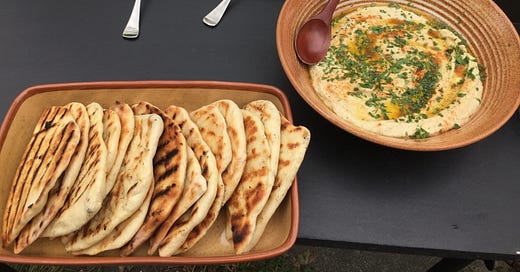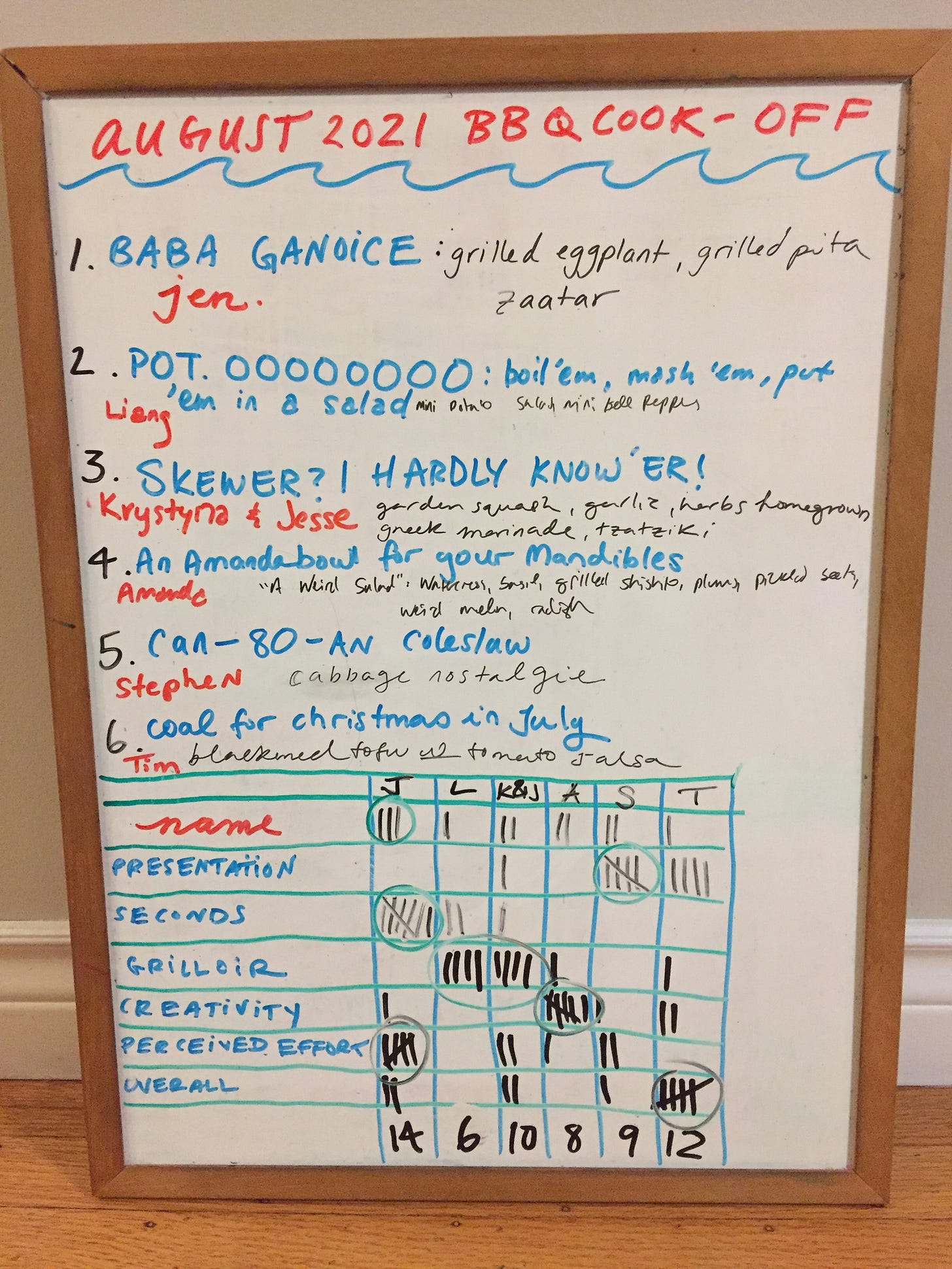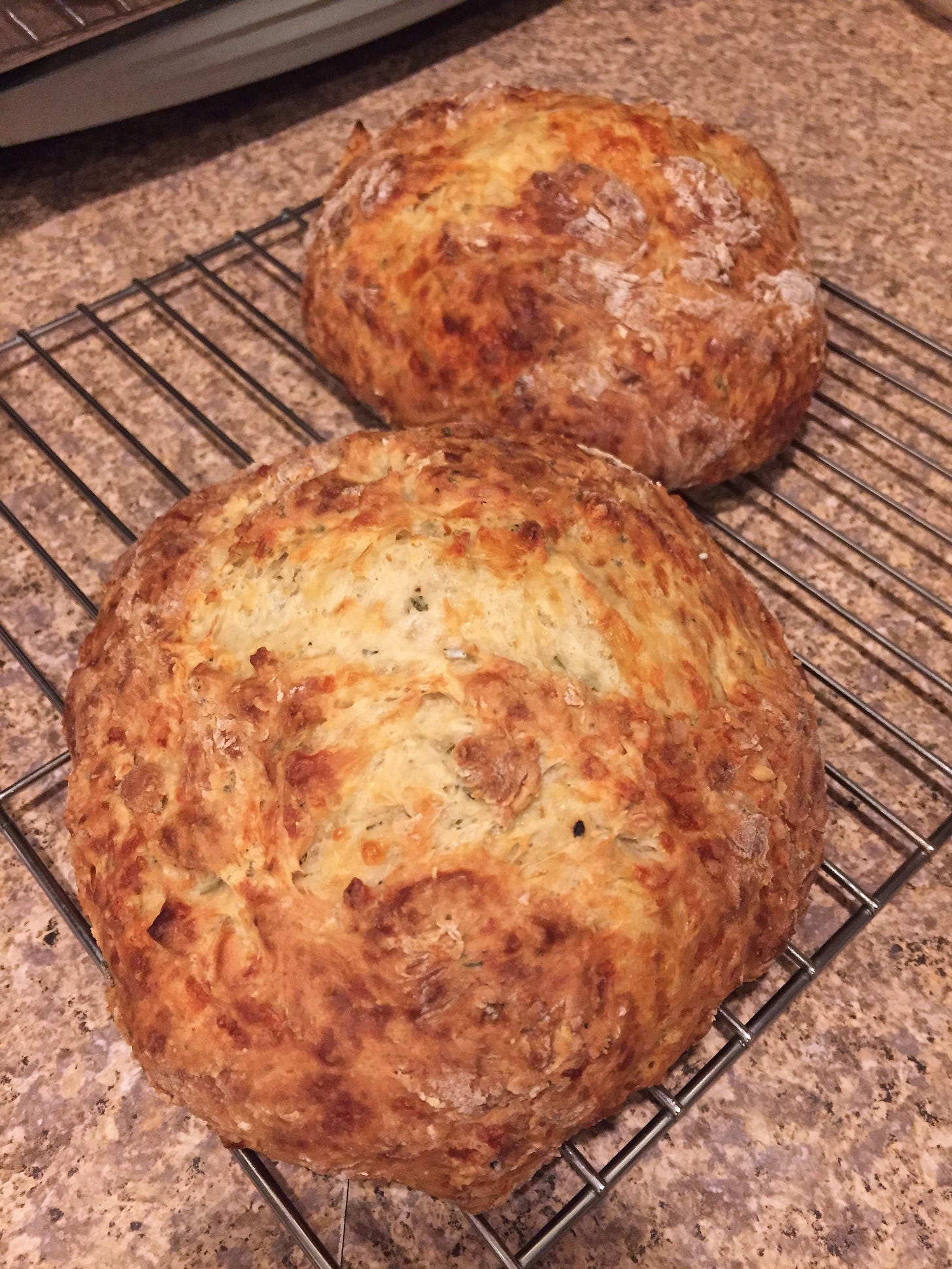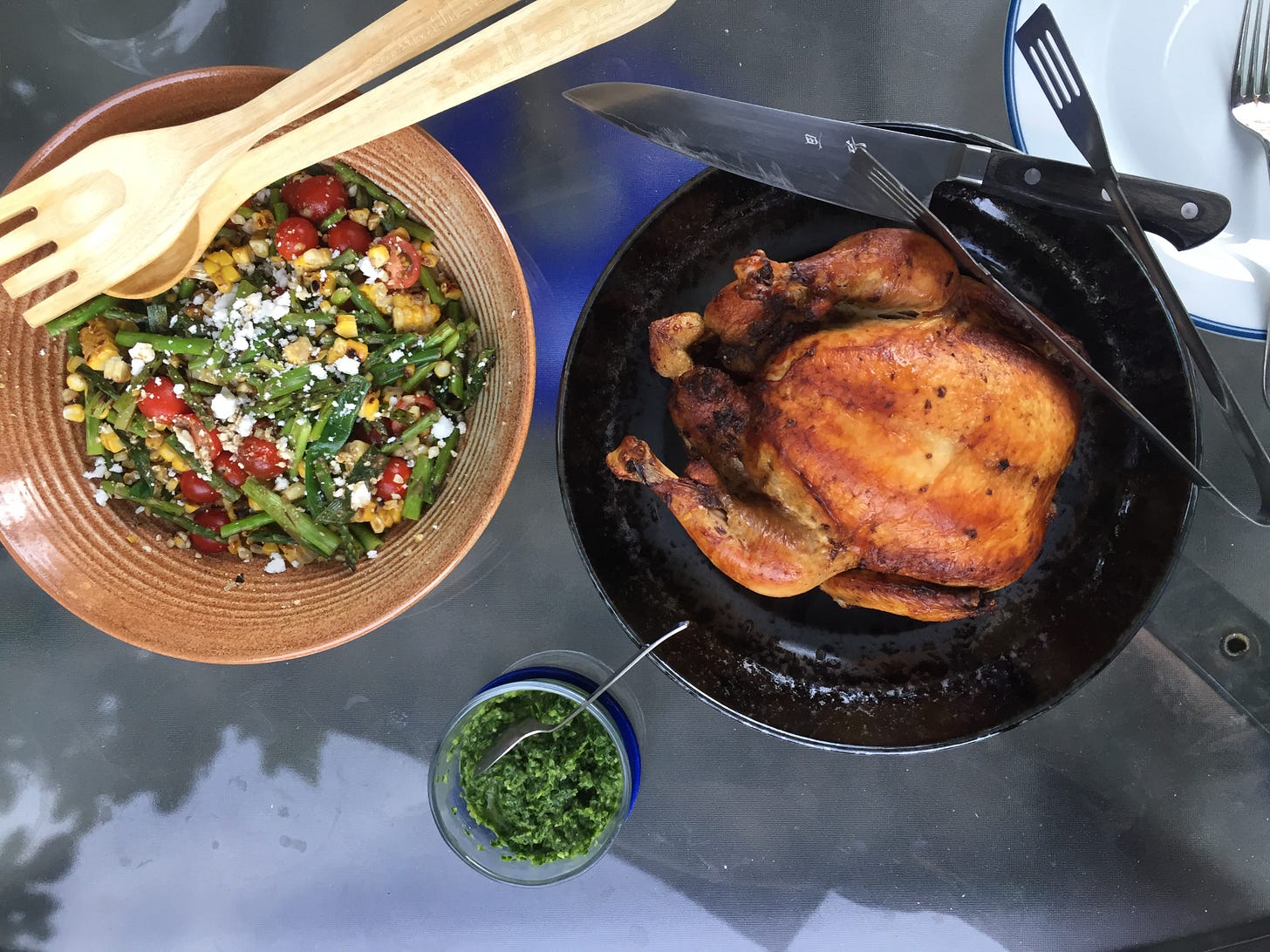
After nearly eighteen months, we were finally able to hold a vegan cookoff. I actually had to erase the scores from the last one, in February 2020, from our whiteboard before the event. All attendees had both doses of the vaccine but to play it extra safe, we chose a theme that would limit our need to go inside for prep: barbecue. We even filled a cooler with ice so that we could put drinks inside it instead of in the fridge. There were ten of us, six entries, and five bottles of wine. It was wonderful to be in the yard with our friends, attempting to pack 6 months’ to a year’s worth of catching up into a few hours’ visit. We kept expressing disbelief that we were actually eating food that was made by other people.
I grilled eggplant for baba ganoush and made pita on the grill as well, sprinkled with za’atar. We also had two mains (blackened tofu, and marinated veg/tofu skewers) and three sides (potato salad, grilled fruit & watercress salad, and a perfect replica of the KFC coleslaw from the 90s), and although a dessert might have been nice, no one went home disappointed. Many people who attend a cookoff for the first time are surprised to learn that it’s less like a potluck and more like a dirtbag version of Iron Chef, so I’ve included a photo of the scoreboard below so you can see that this is serious business. Although the name category doesn’t count towards your final score, we all clearly put a lot of effort into it after so long.
Cookoffs started in 2009 and the competitive aspect of it actually inspired many of us to become better cooks (you can ask any regular attendee about the worst cookoff entry they’ve ever made). Over the years we’ve loved having the excuse to get together each month, and to try something new in the kitchen. We’ll have to see how things are going to find out if we can continue throughout the fall and winter, but we’ve got one more scheduled for September, at least.
I trimmed our rosemary plant this weekend before the cookoff, because it had gotten completely out of hand: four feet tall and getting tangled up in the raspberry bush and the barbecue cover. I posted the extra trimmings on my local Buy Nothing group to see if anyone could use some, and someone linked me to this recipe for rosemary cheddar soda bread, citing it as her favourite thing to make with excess amounts of fresh rosemary. Honestly, bless these moms (and the dad who created the recipe), because it was extremely easy and delicious— I threw it together after work and used the time it was in the oven to make dinner.
“Soda bread” refers to the baking soda which is used as a leavening agent instead of yeast, making this a quick bread which comes together in a dough more like that of scones or biscuits than a traditional bread. If you don’t have cream of tartar, don’t worry— I used a slightly smaller amount of baking powder instead with no harm done. You could also just increase the amount of baking soda a little and it’d be fine. And if buttermilk isn’t a staple in your house, you can do what I did and add a tablespoon of apple cider vinegar to a cup of any other milk and let it curdle, or use half milk and half yogurt. I recommend a strong, aged cheddar for this, since its job is to contrast and complement the rosemary, and a milder cheese won’t hold up once it’s baked.
I chose to make two smaller, rustic round loaves so I could put one in the freezer, and it worked perfectly with the cooking time indicated, so I imagine a full-size loaf might take a little longer (some of the recipe comments confirm this). Although this recipe may not be true to a traditional Irish soda bread, I’m pleased with how it turned out: soft, fragrant, savoury, with lovely crisp edges. I’ve been toasting it for breakfast in the mornings and eating it with just butter and tomatoes.
Most of the year, I think, “eh, I don’t really care for corn one way or the other.” And then corn comes into season and I think, “wow, I fucking love corn.” So I was delighted to find three ears of corn in my produce bin this week, and devoted a not insignificant amount of time trying to find the perfect way to cook them. Eventually I settled on this grilled corn and asparagus salad as an easy way to free myself of multiple things in the produce drawer at once. I was having trouble thinking of something to go with it, and landed on the “fuck it, roast chicken” square of freezer bingo. I tend to buy a local whole chicken when it goes on sale, leave it in my freezer until it goes on sale again several months later, then go to put the new chicken away and realise I still had one in there from before, forcing me to figure out how I want to cook the first one.
I used to be so intimidated by cooking a whole chicken, but it’s very much a low-effort, high-reward venture. I was intrigued by this Peruvian roasted chicken, but didn’t want to mess around with cutting it in half, so I just used the marinade recipe and stuck with the tried and true method outlined in Samin Nosrat’s buttermilk roast chicken. That’s the great thing about her book: the methods are usually straightforward and generalized enough that once you have one recipe, you also have dozens of others at your disposal as you learn to adapt with new variations. Really, all you need is plenty of salt to make the meat juicy and flavourful, and something acidic to keep it tender and balance the salt. This marinade, a spicy blend with soy sauce for saltiness and lime for acidity, has a couple of chile pastes specific to Peruvian cooking, but the recipe offers a couple of pantry-friendly alternatives. I used ancho chile powder and sambal.
For the salad, I used less corn and more tomatoes for a little more body, and grilled just a handful of green onions so they didn’t overpower. The dressing has a similar flavour profile to the marinade: soy, lime, and hot sauce. I added some crumbled feta to serve, to help balance the spicy elements of the meal. This was so satisfying to eat with all the varieties of crunchiness and the char from the grill. The chicken came out just lightly spicy, with salty, crispy brown skin. I made some jalapeño chimichurri to go with it because I had too much parsley, but the chicken was already so juicy and flavourful we didn’t end up using much of it. This was a delicious summer dinner that was equally good cold for lunch the next day (I’m just glad I got around to roasting the chicken before the heat wave kicked in again).
Media:
I was fascinated by this short history of how the Ziploc bag came to be, and our society’s devotion to it. Its ingenuity and versatility have made it a kitchen and household staple that many are reluctant to part with, even as we grapple with the longterm effects of single-use plastics and as more sustainable alternatives become more readily available. But as the article points out, many of these alternatives can seem flawed in comparison: cloth snack bags aren’t freezer-friendly, beeswax versions don’t seal completely, and as far as I know, Stasher doesn’t make a silicone bag big enough to marinate a chicken. Out of guilt I always make an effort to rinse a plastic freezer or sandwich bag after the first use (if it hasn’t been torn or contaminated) so I can use it once or twice more before throwing it away.
With the new report on the climate crisis this week, I see a lot of repeating of the fact that 70% of global emissions are caused by 100 companies. What is left out in the nuance of this statistic is the fact that some of those emissions are due to production costs to meet consumer demand. So then while it’s true that climate change cannot be halted in its tracks by individual choices like using metal straws, it also doesn’t mean that we can absolve ourselves from having to make any lifestyle changes. The final paragraph of the Ziploc article states that SC Johnson created a compostable bag as early as 2013, but eventually phased it out of distribution because consumers didn’t care for it. Maybe it was more expensive than the plastic version. Maybe it wasn’t sold in as many stores. Or maybe people truly didn’t feel that a compostable version would work the same way.
But the time for allowing the so-called free market to dictate what options are available to consumers, when those options have real effects on the world around us, needs to end. Remember when people in the US complained that the new compostable Sun Chips bag was too loud, so they went back to the old bag for fear that people would no longer buy the product? What would happen if it were mandated by law that all chip bags had to be compostable? I’m willing to bet people wouldn’t suddenly stop buying chips. Put another way, if government regulations make the necessary changes to the capitalist forces that are devastating our climate, individual lifestyles will, necessarily, change— eating less meat, driving less often, buying fewer plastic products. So we should begin to accept and enact those changes personally in as many ways as we have the capacity for in the meantime. If anyone needs me, I’ll be over here trying to get this beeswax wrap to stick to half a cucumber.
Thanks for reading— if you enjoyed this newsletter, please share it with someone new! I like providing this to you for free, but it does still involve time and effort, so donations I can use towards cookbooks or future treats are much appreciated. It’s been a bleak week so I don’t have anything funny to share, but as we roll into canning season, please enjoy a moment of peace while you look at this beautiful painting.








